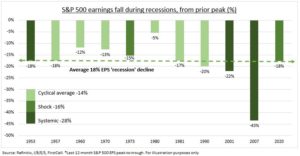RECESSIONS: US recession risks were rising even before the latest FOMC meeting and ‘dot plot’ guidance made it all but inevitable. The NY Fed recession probability indicator is at 25%. The 10-2 year yield curve inverted for two months. Atlanta Fed Q3 GDP NOWCast closing on a negative print after consecutive Q1 and Q2 declines. But recessions are not all created equal. We face a ‘cyclical’ downturn, typically the shortest and least damaging variety of this rare species. It will be painful but still investable, and we see a gradual ‘U-shaped’ market recovery.
FLAVOURS: Recession types can broadly be split into three. 1) ‘Cyclical’ recessions are the most common. As the Fed hikes interest rates to cool high inflation. They last an average of 10 months, with a 2% peak-trough GDP and 14% earnings fall. 2) ‘Shock’ recessions, like the 2020 pandemic or 1973 oil crisis, are uncommon, short-lived, but often have the biggest GDP impact. 3) Whilst ‘systemic’ recessions, like the global financial crisis, are also uncommon. But have the largest earnings impact (-28%), with big GDP falls (-3%). They also typically last the longest.
VERSION 2023: The coming recession is ‘cyclical’. With central banks hiking interest rates to combat inflation. But all recessions are different and our data set is limited with only twelve US recessions since WWII. Central Banks have been late to raise rates this time. Whilst much of inflation is driven by the prior pandemic ‘shock’ recession. It may now take longer to bring inflation back to the 2% target. But, crucially, this is not a ‘systemic’ downturn. Households have deleveraged. Labour markets are strong. Companies near record profits. Banks well-capitalized. Risk is high but this is not an uninvestable downturn. Our market recovery tracker is balanced.

All data, figures & charts are valid as of 22/09/2022



